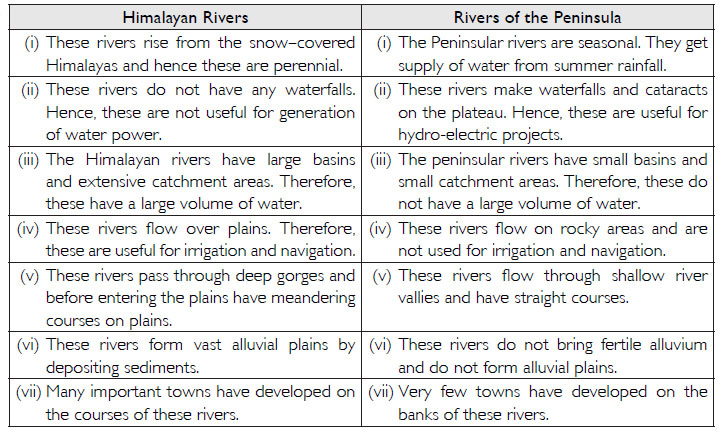Question 1:
In which of the following states/union territories is the Wular lake located?
- Rajasthan
- Uttar Pradesh
- Punjab
- Jammu and Kashmir
Answer:
(d) Jammu and Kashmir
Question 2:
The river Narmada has its source at –
- Satpura
- Brahmagiri
- Amarkantak
- Slopes of the Western Ghats
Answer:
(c) Amarkantak
Question 3:
Which one of the following lakes is a salt water lake?
- Sambhar
- Dal
- Wular
- Gobind Sagar
Answer:
(a) Sambhar
Question 4:
Which one of the following is the longest river of the Peninsular India?
- Narmada
- Krishna
- Godavari
- Mahanadi
Answer:
(c) Godavari
Question 5:
Which one amongst the following rivers flows through a rift valley?
- Mahanadi
- Tungabhadra
- Krishna
- Tapi
Answer:
(d) Tapi
Question 6:
What is meant by a water-divide? Give an example.
Answer:
A raised area separating the head streams of two different river systems is called a water-shed or water-divide. In India, the Ganga river system flows eastward and drains into the Bay of Bengal, while the Indus river system flows westward and drains into the Arabian Sea. The area near Ambala with a height of 283 metres is the water divide between the Ganga and the Indus. It separates two drainage basins.
Question 7:
Which is the largest river basin in India?
Answer:
The Ganga-Brahmaputra river basin is the largest in India. The Ganga river is 2,525 km. long and the Brahmaputra river is 2,900 km. long. The two rivers join together to form the largest delta of the world.
Question :
Where do the river Indus and Ganga have their origin?
Answer:
River Indus and Ganga are Himalayan rivers.
(a) River Indus rises in Tibet near Lake Mansarovar.
(b) River Ganga rises from the Gangotari Glacier.
Question 8:
Name the two headstreams of the Ganga. Where do they meet to form the Ganga?
Answer:
The head waters of the Ganga called the Bhagirathi is fed by the Gangotari Glacier and is joined by the Alaknanda at Devaprayag in Uttarakhand. The two join to form the Ganga river.
Question 9:
Why does the Brahmaputra in its Tibetan part have less silt, despite a longer course?
Answer:
Most of the course of the Brahmaputra lies in Tibet. It enters India in Arunachal Pradesh. The river is called Tsangpo in Tibet. Here, the volume of water of the river is less and has less silt. But in India, the river has large volume of water and more silt. The river has a braided channel in Assam.
Question 10:
Which two Peninsular rivers flow through a trough?
Answer:
Narmada and Tapi.
Question 11:
State some economic benefits of rivers and lakes.
Answer:
Economically, rivers are very beneficial for a nation’s economy. Rivers provide us valuable resources such as alluvial soils, water for irrigation facilities, water transports in coastal regions, etc. Recreation, tourist promotion and fishing are also being developed along water fronts to gain economic benefits.
Question 12:
Below are given names of a few lakes of India. Group them under two categories—natural and
created by human beings.
(a) Wular (b) Dal (c) Nainital (d) Bhimtal (e) Gobind Sagar
(f) Loktak (g) Barapani (h) Chilika (i) Sambhar (j) Rana Pratap Sagar
(k) Nizam Sagar (l) Pulicat (m) Nagarjuna Sagar (n) Hirakud.
Answer:
Natural lakes: (a) Wular, (b) Dal, (c) Nainital, (d) Bhimtal, (f) Loktak, (g) Barapani, (h)
Chilika, (i) Sambhar, (l) Pulicat.
Man-made lakes: (e) Gobind Sagar, (j) Rana Partap Sagar, (k) Nizam Sagar, (m) Nagarjuna
Sagar, (n) Hirakud.
Question 13:
Discuss the significant difference between the Himalayan and the Peninsular rivers.
Or
How are Peninsular rivers different from Himalayan rivers? Give three points to distinguish.
Answer:

Question 14:
Compare the east flowing and the west flowing rivers of the Peninsular Plateau.
Answer:
Question 15:
Why are rivers important for the country’s economy?
Or
Explain the role of rivers in the economy of a country.
Or
Explain any three reasons of significance of rivers in the economy of a country.
Answer:
Role of Rivers in the Economy
(a) Cultural Importance: Rivers have been of fundamental importance throughout human
history. The areas along the banks of rivers have witnessed great cultural and economic
progress since ancient times. Rivers are an integral part of our folklore and folk
songs.
(b) A Natural Resource: Water from the rivers is a basic natural resource, essential for
human, agricultural and industrial activities.
(c) Agricultural Areas: Rivers and their associated alluvial soils provide the most
productive agricultural lands of the country. The Ganga, the Kaveri and other deltas have
traditionally been the rice growing areas. An agriculture dependent on the variability of
the monsoons, irrigation from rivershas been the backbone of the development of Indian
agriculture.
(d) Settlements: The valleys contain dense and concentrated settlements. Most of the large
cities are located on rivers. Not only do rivers provide us with essential water supplies,
but they also receive, dilute and wash away wastes from settlements.
(e) Industrial Development: Industrial development has flourished along the rivers as many
industrial processes rely on water – as a raw material, as a coolant and for the generation
of hydroelectricity.
(f) Transportation: Rivers provide primary channels of inland transportation, not only
directly in the form of navigable waterways, but also indirectly through their valleys,
where roads, railway lines and other routes are built.
(g) Tourism: Recreation, tourist promotion and fishing are also being developed along water
ways.
Question 16:
Which river has the largest river basin in India?
Answer:
The Ganga-Brahmaputra River basin is the largest river basin in India.
Question 17:
The name of the biggest waterfall in India.
Answer:
Kunchikal fall is the biggest waterfall in India.

